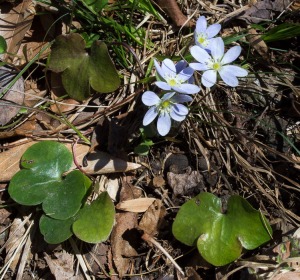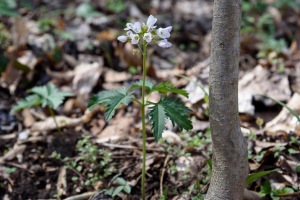
Virginia bluebells carpeting a Potomac River floodplain last spring
Happy new year! I’m back, after a truly epic case of writer’s block. Not that there’s anything blooming to write about yet, since the local wildflower show won’t be starting until late February at the earliest, more likely mid-March if this winter stays as cold as it has been. Which has been pretty darn cold compared to the last five years or so, but not that unusual compared to, say, the past 50 years.
At any rate I’m fighting the winter blues by recalling blue flowers I found this past year. Here are a few from the Maryland Piedmont.
 Anemone americana (formerly Hepatica nobilis var obtusa; round-lobed hepatica; Ranunculaceae)
Anemone americana (formerly Hepatica nobilis var obtusa; round-lobed hepatica; Ranunculaceae)
This species is hibernal – the basal rosette of leaves will be out right now, though likely hidden under leaf litter. The leaves will die back as the small flowers appear just an inch or two off the ground. In the Piedmont I’ve seen them as early as early March and as late as mid April, though they don’t bloom for long; they just seem highly variable about when they start blooming.
 Baptisia australis (wild blue indigo; Fabaceae)
Baptisia australis (wild blue indigo; Fabaceae)
This species is found primarily in prairies, but also occurs in some prairie-like habitats east of the Appalachians, including bedrock terraces in the Potomac gorge. According to the Maryland DNR’s new RTE list, there are only a few populations here. It’s listed S2/Threatened. Finding it is a real treat.
 Clitoria mariana (Atlantic pigeonwings, butterfly pea; Fabaceae)
Clitoria mariana (Atlantic pigeonwings, butterfly pea; Fabaceae)
I’ve only seen this in a few places, always in rocky areas in a bit of shade, and there’s never much of it. Start looking in mid June.

Conoclinium coelestinum (formerly Eupatorium coelestinum; blue mistflower; Asteraceae)
This medium-height plant blooms from June through September in wet soils next to the Potomac River – not right on the banks, but close by.

Houstonia caeulea (azure bluet, little bluet, Quaker ladies; Rubiaceae)
These tiny flowers bloom en masse in April and May in moist, rocky soils in open wooded areas. Sometimes you’ll see only a few, but other times you may find them carpeting a meadow. They are really tricky to photograph up close, as even the slightest breeze sets them in motion.
 Ionactis linariifolia (formerly Aster linariifolius; flax-leaved aster; Asteraceae)
Ionactis linariifolia (formerly Aster linariifolius; flax-leaved aster; Asteraceae)
I’ve seen this species blooming in a rocky meadow in the Carderock area in October of the last few years, but also in open, rocky areas of the Billy Goat A trail – in June!
 Iris species, either I. versicolor or I. virginica (northern blue flag or southern blue flag; Iridaceae)
Iris species, either I. versicolor or I. virginica (northern blue flag or southern blue flag; Iridaceae)
These flowers drove me nuts in 2017. I posted many times about my quest to determine exactly which species it is. There are scattered stands along and near the C&O Canal from the Marsden Tract upstream to Widewater; look for it in late May or early June.
 Lobelia siphilitica (great blue lobelia; Campanulaceae) stands dramatically tall on riverbanks. I’ve seen two stands of them along the Potomac: one just upriver of the American Legion bridge, the other near Fletcher’s Boathouse in DC.
Lobelia siphilitica (great blue lobelia; Campanulaceae) stands dramatically tall on riverbanks. I’ve seen two stands of them along the Potomac: one just upriver of the American Legion bridge, the other near Fletcher’s Boathouse in DC.

Mertensia virginica (Virginia bluebells; Boraginaceae)
This spring ephemeral often grows in large swaths in floodplains, like in the lead-in photo above. The pink buds start turning blue as they open. This species can also flower in pure white, pure pink, and pale violet; I love hunting for these variations every April.

Phacelia covillei (Coville’s phacelia, buttercup scorpionweed; Boraginaceae)
A short annual plant with tiny flowers that have to be seen up close to be appreciated. Currently listed S2/Endangered by the Maryland DNR, with a proposed change of status to Threatened.

Phacelia dubia (small-flowered phacelia or scorpionweed; Boraginaceae)
A fellow botanerd directed me to a large stand of this species last spring. Most of those flowers appeared white, but up close a few had this pale blue cast.

Phacelia purshii (fringed phacelia, Miami mist; Boraginaceae)
Listed S3 in Maryland. I’ve found only three stands of it between the Potomac and the Billy Goat B and C trails.

Scutellaria elliptica (hairy skullcap; Lamiaceae)
Look for sparse stands of these from Carderock to the Marsden Tract, in rocky soils where the woods aren’t too dense.

Tradescantia virginiana (Virginia spiderwort; Commelinaceae)
In some lighting situations this flower looks more purple than blue, but oh well. I’ll cover purple flowers in a future post. The plant has iris-like foliage: broad blades with parallel veins. The three-petaled flowers are another clue that this plant is a monocot. Which gives me an idea for another future post.
 Monday dawned sunny and cool, beautiful weather for wildflower hunting. Despite my resolution to stay put during this health crisis, I decided it might be worth trying Rachel Carson Conservation Park. It was a good call – for most of the time I was there, I had the place to myself.
Monday dawned sunny and cool, beautiful weather for wildflower hunting. Despite my resolution to stay put during this health crisis, I decided it might be worth trying Rachel Carson Conservation Park. It was a good call – for most of the time I was there, I had the place to myself. That’s the good news. The not-so-good news is that it’s too early in the season for some of the flowers I wanted to see. But there were other things blooming, like round-lobed hepatica (Anemone americana; Ranunculaceae).The flower colors can vary from white through pale blue to a deep, almost purple blue, and sometimes even pink.
That’s the good news. The not-so-good news is that it’s too early in the season for some of the flowers I wanted to see. But there were other things blooming, like round-lobed hepatica (Anemone americana; Ranunculaceae).The flower colors can vary from white through pale blue to a deep, almost purple blue, and sometimes even pink. 




































